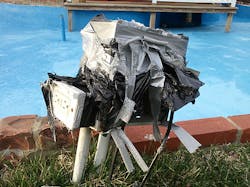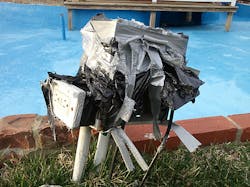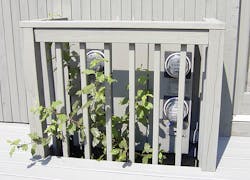Illustrated Catastrophes: Maximum Violations at Mini Golf Course
All references are based on the 2014 edition of the NEC.
Maximum Violations at Mini Golf Course
These photos were sent in by a reader who wishes to remain anonymous. He took them while playing miniature golf with his wife. According to him, “This is an area where masses of young people play, and a lot of people with no knowledge of the dangers of electricity come to have fun.”
The first safety concern I will point out is the improper support of the PVC boxes. PVC pipe cannot be used to support boxes in this manner. Section 352.12(B) specifies that PVC cannot be used to support luminaires or other equipment. Section 352.10(H) permits conduit bodies (but not boxes) to be supported by PVC.
My next concern is the broken and missing cover on the receptacle. Section 406.9(B)(1) requires a weatherproof enclosure for this 15A, 125V receptacle because it is located in a wet location. A listed “extra-duty”-rated outlet box hood and a receptacle listed as “weather-resistant” is also required by this same section of the Code.
The broken pipes and the duct tape used in place of the broken box cover are violations of Sec. 110.12(B), which states, “There shall be no damaged parts that may adversely affect safe operation or mechanical strength of the equipment…”
That’s Nothing a Chain Saw Won’t Fix!
Section 240.24(A) requires overcurrent devices to be readily accessible. Because these circuit breakers are not capable of being reached quickly for inspection, operation, or renewal — without using a saw to cut away the spindles or a sledge hammer to smash apart the railing — they do not meet the definition of readily accessible.
Section 110.26 requires working space and access to be provided and maintained around all electrical equipment to allow safe operation and maintenance of the equipment. For equipment likely to be serviced while energized, 110.26(A) provides minimum depth, width, and height requirements as follows:
• According to Table 110.26(A)(1), the minimum depth required in front of this 120V/240V equipment would be 3 ft.
• 110.26(A)(2) requires a minimum working space width of 30 in. in front of this equipment. If the equipment is wider than 30 in., the working space width cannot be less than the width of the equipment. Hinged equipment doors or panels must be able to open at least 90° in all cases.
• 110.26(A)(3) requires the working space in front of this
equipment to be clear from the grade or floor to a height of at least 6½ ft or the height of the equipment — whichever is higher.
About the Author

Russ LeBlanc
Owner
Russ started in the electrical trade as an apprentice in 1985. He worked his way up to become a Journeyman Electrician and then eventually became a Master Electrician and Licensed Construction Supervisor. In 1999 Russ become an Electrical Instructor for The Peterson School of Engineering in Massachusetts where he developed his passion for teaching, and quickly became Department Head of Electrical Instruction. Russ has taught thousands of apprentices, electricians, engineers, inspectors, and other electrical professionals during his career as an instructor. He continues to provide electrical professionals with Electrical Code seminars, Arc-Flash Awareness training seminars and educational material through his LeBlanc Consulting Services in North Reading, MA whose specialty is educating electricians. He has been an active member of the NFPA Electrical Section and has authored hundreds of National Electrical Code proposals and comments which have become Code rules to improve the safety for the electrical industry. Russ is also an IAEI certified Electrical Inspector.
Please visit www.russleblanc.net for more information.



